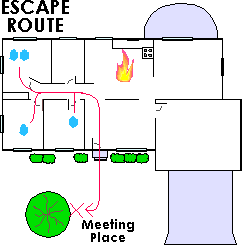Escape Planning
Exit Drills In The Home (E.D.I.T.H.)
Children age 5 and under represent 9% of the population, yet they comprise nearly 22% of all residential fire-related deaths. They are more than twice as likely to die in a fire than the rest of the population, according to theNational Safe Kids Campaign. Approximately 25,000 children age 4 and under are injured in residential fires each year. Teaching our children what to do in case of a fire isn't enough. These skills need to be reinforced through practice drills with the whole family.Before Your First Drill
Reassure children that they can learn to get out of a fire and that you will practice it with them. Also, talk with them about fire facts. Explain the importance of understanding and knowing what fire is capable of.
Fire Is DARK
- Fire is black.
- Smoke is thick.
- In this darkness, you cannot see flames.
- The smell of smoke does not wake you. Smoke detectors do.
- Fire uses up the oxygen you breath.
- You become disoriented from the poisonous gases.
- In less than 2 minutes you can pass out from poisonous smoke and gases.
- Within 5 minutes ceiling temperatures reach 1000° F, 600° F at eye level and 90° F near the floor.
- The temperature can sear your lungs.
- Clothing melts onto your skin.
- The fire's heat is worse than it's flames.
- In 30 seconds flames can be out of control.
- In 2 minutes a room can be life threatening.
- In 5 minutes a house can be filled with flames
- Every second must be used to GET OUT!! There is little time to think.
Prepare Your Family's Escape Plan
Preparing your family's escape plan requires little effort but is very important.

- Use A Map - Parents should draw out a map of the home showing all doors and other possible exit points like windows. Don't worry about the artistic quality! This map is a great starting point for your drill. Each child's possible exits should be shown on the map and then identified in the home. At least two possible exits should be shown.
- Maintenance Check - All windows and doors should be clear of clutter and open easily and fully. Smoke detectors should be cleaned and tested. This not only ensures that these important devises are working, but also allows all to hear the sound made.
- Doors Closed - All bedroom doors should be shut at night. This helps to hold back the spread of smoke and heat in the case of a fire.
- Meeting Location - All should agree on a fixed permanent location outside where family members can meet for a head count. Ensure that this location is a safe distance away from the home, away from possible hazards.
- Once Out, Stay Out - Once out, one member of the family should use a neighbor's phone to call the emergency number. All others should stay out of the house, not going back in for any reason. Be available to instruct the arriving fire fighters of any family members still in the house and their possible location. This is extremely important!
- Practice, Practice, Practice - Children need repeated exposures to new topics in order to learn the skill.
Evacuating A Burning Building
- Leave the building as soon as you hear the smoke detector. Every second counts!
- Quickly proceed to the exit outlined in your escape plan without stopping to gather material items.
- Before opening a closed door, test for heat using the back of your hand. If the door is hot, use the secondary exit outlined in your escape plan. If no safe exit exists, seal cracks around doors and vents with anything available to prevent smoke and gasses from entering the room.
- When leaving a room, close but do not lock the door behind you. This can help slow or stop the spread of the fire.
- Always stay low to avoid smoke and toxic gasses. Since hot air rises, cooler, cleaner air is available close to the floor.
Other Escape Tips
When staying away from home, always take a few moments to review the fire escape plan posted on the back of the hotel room's door. Walk the escape route once with all family members in order to gain a sense of direction.
BACK to the Public Education Main Page